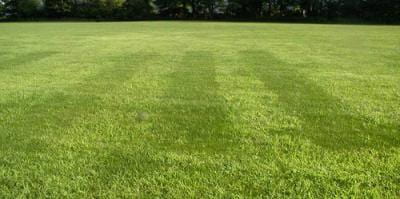
Overseeding is the periodic application of seed to an existing turfgrass stand to improve turf density. A widely accepted concept is that 25 events on a native soil football field is the limit for optimum turfgrass recovery. The grass cannot recuperate quickly enough when used for games, practices, gym class and other school activities. So overseeding must be done on a routine basis on high-use fields if there is any chance of providing a dense, more uniform, and safe playing surface.
Grass species selection
Selection depends on several factors including: overall goal of field quality, resources for follow up maintenance, irrigation capabilities, etc. Review options in the Grass section. For added insurance always select those varieties that have superior wear tolerance. For detailed cultivar performance information check the National Turfgrass Evaluation Program website.
Consider aggressive overseeding
An excellent time to overseed is right after aerifying or cultivating your field.
Research at Cornell and other universities found that overseeding weekly under high traffic conditions with either perennial ryegrass or tall fescue provided excellent season-long turf density. Perennial ryegrass was able to maintain almost 90% density and the tall fescue plots had between 70% and 80% density at the end of the study.
Note: Overseeding with Kentucky bluegrass (KBG) proved completely ineffective under regular traffic most likely due to the long germination and establishment requirement.
The non-overseeded plots were less than 50% covered with turf and in some cases up to 20% weeds.
Routine overseeding provided a dense, more uniform, safe playing surface.
When to overseed
Involving coaches and players not only reduces labor needs during difficult economic times, but also emphasizes that everyone has a role in maintaining dense, more uniform and safer playing surfaces.
In-season broadcast seed over high use areas and allow athletes to cleat-in the seed. You can also fill in divots with a mixture of soil and perennial ryegrass seed a few days in advance of a game or expected field use. Mix seed with soil (1 part seed to 10 parts soil) to make the divot mix. Involve coaches and players to help repair the field after every heavy use.
After the fall season is over, fields are worn thin creating an ideal seedbed for overseeding KBG. There also is little competition from remaining perennial ryegrass or other species. Aggressively core, drag the field and broadcast KBG seed When the soils warm up in the spring the KBG will out compete other species in the stand. This is a particularly effective strategy to improve the KBG stand when the late fall seeding has 2 to 3 months to establish without play and no play is planned for the following spring.
Overseeding rates for quick cover
| Species and Mixtures | Pounds of seed per 1,000 sq. ft. |
|---|---|
| Kentucky bluegrass (use several improved varieties) | 2½ – 3½ |
| Perennial ryegrass (use several improved varieties) | 10-15 |
| Tall fescue (use several improved varieties) | 10-15 |
| Kentucky bluegrass/perennial ryegrass (80:20 mixture) | 3-4 |
| Tall Fescue/Kentucky Bluegrass (90:10 mixture) | 10-15 |
Worth the investment!
Some budgets are large enough to pay for overseeding the entire field periodically. If having better coverage and less weed pressure are your goals then the benefits of an aggressive overseeding program will outweigh the cost.
But what if you had limited resources? You could concentrate your overseeding program in the areas that receive the most traffic (goal mouths, or between the hash marks and 20 yard lines) to reduce the cost. The chart below estimates the cost of an aggressive overseeding program when focusing on only high use areas.
Cost of aggressively overseeding high use areas of sports fields with perennial ryegrass at 2 lbs. of seed per 1,000 square feet
| Field Type/
High use area in sq. ft. |
Seeding Rate | Cost | Results | ||
|---|---|---|---|---|---|
| Pound of seed | Weekly cost | 13 week season | |||
| Soccer Field
22,000 sq. ft. |
2 lbs. per 1,000 sq. ft. | $2.00 | $88 | $1,144 |
Better turf density/coverage. Less weed pressure to deal with. |
| Football Field
16,000 sq. ft. |
2 lbs. per 1,000 sq. ft. | $2.00 | $64 | $832 | |
But what if you had limited resources? You could concentrate your overseeding program in the areas that receive the most traffic (goal mouths, or between the hash marks and 20 yard lines) to reduce the cost.
Preparing for overseeding
- Mow the grass short.
- Aerify the field by punching at least 20-40 holes/ft2 with the largest hollow tines available and make several passes.
- Drag the field to break up cores and provide a desirable seedbed.
- Apply the seed with a drop seeder and make several passes to ensure a uniform seeding.
- Do not allow the seedbed to dry out. Water to keep the surface moist.
- After the grass has germinated, apply ½ lb. per 1,000 sq. ft. of a nitrogen fertilizer containing at least 60 percent slow release N if your soil is sandy to minimize leaching and water pollution. If your soil is a non-sand soil apply ½ lb. of a nitrogen fertilizer containing at least 30 percent slow release.
See also: Overseeding athletic fields and lawns for ecological control of weeds.


